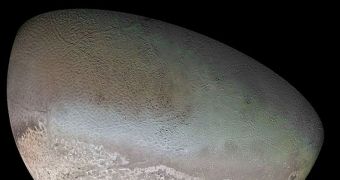In a paper published in the August issue of the astronomical journal Icarus, experts at the University of Maryland raise the interesting prospect that Triton, the largest moon orbiting Neptune, may have an ocean of liquid water underneath its icy surface.
Astronomers first learned that Triton's surface was mainly made up of water ice in 1989, when the Voyager 2 spacecraft flew past the moon, on its way out of the solar system. The finding came as somewhat of a shock, though it was not entirely unexpected.
What was very interesting for scientists to notice was that the ice contained nitrogen, methane, and carbon dioxide, in relatively large amounts. The moon is also rather dense, indicating that its core could be made up of silicate rock.
If that is indeed the case, the new study argues, then it may have been possible for an ocean of liquid water to form between the rocky core and the extremely strong ice above. This layer could be responsible for providing lubrication between the core and surface ice.
As soon as experts established this as a possibility, the research became a matter of figuring out whether or not such an underground ocean may have survived until now. An important factor to consider was the retrograde orbit Triton occupies, Astrobiology Magazine reports.
A retrograde orbit, in basic terms, means that Triton circles Neptune to the left, while the ice giant moves around its axis to the right. The motions of the two bodies are opposite, and this is quite rare.
This is a dead giveaway of the fact that the moon was most likely captured in orbit around the large planet, having formed somewhere else, and then made its way towards the inner solar system.
A direct consequence of Triton being captured by Neptune's gravity would have been a highly elliptical orbit around the planet, which would have produced massive tidal waves on the moon. These waves interacted through friction, causing a lot of heat to be produced.
Within the moon, this heat may have melted some of the innermost layers of ice, producing highly compressed liquid water. Gradually, Triton's orbit moved from elliptical to circular, leading to lower and lower tidal waves.
“While the concentration of tidal dissipation near the bottom of ice shells was known for some time, we believe our work is the first to demonstrate that it indeed controls the rate of freezing and sustainability of subsurface oceans,” UM expert Saswata Hier-Majumder says.
Radiogenic heating – the decay of radioactive elements within the moon – “in comparison, heats up the shell uniformly, and thus doesn't have as disproportionate an influence as tidal dissipation does,” the expert concludes.

 14 DAY TRIAL //
14 DAY TRIAL //